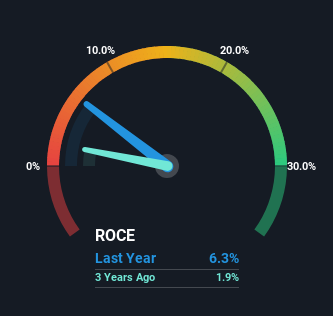- China
- /
- Oil and Gas
- /
- SZSE:000968
Shanxi Blue Flame Holding (SZSE:000968) Will Want To Turn Around Its Return Trends

If we want to find a stock that could multiply over the long term, what are the underlying trends we should look for? Typically, we'll want to notice a trend of growing return on capital employed (ROCE) and alongside that, an expanding base of capital employed. This shows us that it's a compounding machine, able to continually reinvest its earnings back into the business and generate higher returns. Having said that, from a first glance at Shanxi Blue Flame Holding (SZSE:000968) we aren't jumping out of our chairs at how returns are trending, but let's have a deeper look.
Return On Capital Employed (ROCE): What Is It?
For those that aren't sure what ROCE is, it measures the amount of pre-tax profits a company can generate from the capital employed in its business. To calculate this metric for Shanxi Blue Flame Holding, this is the formula:
Return on Capital Employed = Earnings Before Interest and Tax (EBIT) ÷ (Total Assets - Current Liabilities)
0.063 = CN¥601m ÷ (CN¥11b - CN¥1.6b) (Based on the trailing twelve months to June 2024).
Therefore, Shanxi Blue Flame Holding has an ROCE of 6.3%. In absolute terms, that's a low return and it also under-performs the Oil and Gas industry average of 10%.
See our latest analysis for Shanxi Blue Flame Holding

Above you can see how the current ROCE for Shanxi Blue Flame Holding compares to its prior returns on capital, but there's only so much you can tell from the past. If you'd like to see what analysts are forecasting going forward, you should check out our free analyst report for Shanxi Blue Flame Holding .
So How Is Shanxi Blue Flame Holding's ROCE Trending?
On the surface, the trend of ROCE at Shanxi Blue Flame Holding doesn't inspire confidence. Over the last five years, returns on capital have decreased to 6.3% from 16% five years ago. On the other hand, the company has been employing more capital without a corresponding improvement in sales in the last year, which could suggest these investments are longer term plays. It's worth keeping an eye on the company's earnings from here on to see if these investments do end up contributing to the bottom line.
On a side note, Shanxi Blue Flame Holding has done well to pay down its current liabilities to 14% of total assets. That could partly explain why the ROCE has dropped. Effectively this means their suppliers or short-term creditors are funding less of the business, which reduces some elements of risk. Since the business is basically funding more of its operations with it's own money, you could argue this has made the business less efficient at generating ROCE.
The Bottom Line On Shanxi Blue Flame Holding's ROCE
To conclude, we've found that Shanxi Blue Flame Holding is reinvesting in the business, but returns have been falling. Since the stock has declined 39% over the last five years, investors may not be too optimistic on this trend improving either. On the whole, we aren't too inspired by the underlying trends and we think there may be better chances of finding a multi-bagger elsewhere.
If you'd like to know about the risks facing Shanxi Blue Flame Holding, we've discovered 2 warning signs that you should be aware of.
For those who like to invest in solid companies, check out this free list of companies with solid balance sheets and high returns on equity.
If you're looking to trade Shanxi Blue Flame Holding, open an account with the lowest-cost platform trusted by professionals, Interactive Brokers.
With clients in over 200 countries and territories, and access to 160 markets, IBKR lets you trade stocks, options, futures, forex, bonds and funds from a single integrated account.
Enjoy no hidden fees, no account minimums, and FX conversion rates as low as 0.03%, far better than what most brokers offer.
Sponsored ContentNew: Manage All Your Stock Portfolios in One Place
We've created the ultimate portfolio companion for stock investors, and it's free.
• Connect an unlimited number of Portfolios and see your total in one currency
• Be alerted to new Warning Signs or Risks via email or mobile
• Track the Fair Value of your stocks
Have feedback on this article? Concerned about the content? Get in touch with us directly. Alternatively, email editorial-team (at) simplywallst.com.
This article by Simply Wall St is general in nature. We provide commentary based on historical data and analyst forecasts only using an unbiased methodology and our articles are not intended to be financial advice. It does not constitute a recommendation to buy or sell any stock, and does not take account of your objectives, or your financial situation. We aim to bring you long-term focused analysis driven by fundamental data. Note that our analysis may not factor in the latest price-sensitive company announcements or qualitative material. Simply Wall St has no position in any stocks mentioned.
About SZSE:000968
Shanxi Blue Flame Holding
Engages in the exploration, development, and utilization of coal mine gas.
Excellent balance sheet and fair value.
Market Insights
Community Narratives




